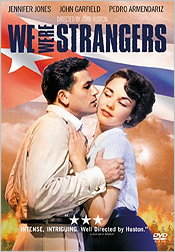 |
Site created 12/15/97.

page created: 2/15/05
 Barrie Maxwell - Main Page |
| Classic
Reviews Roundup #15 - February 2005 In this edition of the Classic Reviews Roundup, I cover 14 films that offer romance (Random Harvest), comedy (The Matchmaker, A New Kind of Love), music (My Sister Eileen), and drama (We Were Strangers, Across the Bridge, Bunny Lake Is Missing, Return to Peyton Place, plus six Warner gangster films - Little Caesar, The Public Enemy, The Petrified Forest, Angels with Dirty Faces, The Roaring Twenties, and White Heat). As usual the reviews are ordered by original release date Warner Bros. Pictures Gangsters Collection (1930-1949) (released on DVD by Warner Bros. on January 25th, 2005) As a long-time fan of the Warner studio output of the Hollywood Golden Age, it's a real pleasure to see this collection finally appear. It contains (for those who may have somehow been completely incommunicado DVD-wise for the past four months) six classic gangster films - Little Caesar (1930), The Public Enemy (1931), The Petrified Forest (1936), Angels with Dirty Faces (1938), The Roaring Twenties (1939), and White Heat (1949). Each of Warners' gangster specialists (Cagney, Robinson, and Bogart) is represented at least once with Cagney fans being particularly fortunate in having four appearances by him. |
| In
1930's Little Caesar, Edward
G. Robinson firmly solidified himself as one of Warners' gangster
stars, having already begun to establish his credentials in The
Widow from Chicago earlier that year. The film chronicles
the rise and fall of Caesar Enrico Bandello, a hoodlum (supposedly
inspired by Al Capone) who manages to control much of the bootleg
liquor activity in Chicago's North Side before things turn against
him. It's a tour-de-force for Robinson told in a punchy, staccato
fashion that would be the prototype for many future Robinson
portrayals as well as introducing his trademark cigar. Behind the
camera was director Mervyn LeRoy who would be associated with so
many of the Warner socially-conscious dramas of the early 1930s,
honing a minimalist style that made the most of Warners' tight
scripts and restricted sets by employing interesting camera angles
and varied lighting to good but not showy effect. The Public Enemy followed soon after in 1931 and made a star of James Cagney. He plays a street hoodlum named Tom Powers who aspires to power in the underworld during the Prohibition Era. He never rises as high as Rico in Little Caesar, but his aspirations lead to the same end if not in quite as squalidly a fashion. Cagney immediately establishes the energy and inventiveness that characterized his portrayals throughout his career. His ability to embellish the simplest situations with a neat turn of phrase, an unexpected facial expression, or a unique action lifted him above most of his fellow actors and is what makes his films timeless from an acting style point-of-view. The Public Enemy also benefits from thoughtful work by director William Wellman who mixes up his camera angles well, conveys action offscreen effectively, and orchestrates some particularly memorable scenes including the machine-gun attack on the Powers brothers and the film's powerful last scene. The first Warner gangster cycle's heyday lasted from 1930 until 1934 when the Production Code started to have real teeth and the public began to tire of the genre. Players like Cagney and Robinson moved over onto the side of law and order during the middle of the decade in films such as G-Men in 1935 and Bullets or Ballots in 1936. Outright gangster films did persist during these years, but they were more likely to be B productions with second-level casts. One exception was 1936's The Petrified Forest which featured the third of the Warner gangster big three - Humphrey Bogart. Bogart had already suffered through earlier Hollywood stints at Fox and Warners without much notice, but his success as gangster Duke Mantee on Broadway in the Robert Sherwood play of The Petrified Forest led to his big break. At the insistence of the play's star Leslie Howard, Warner Bros. agreed to film the play with Bogart reprising his stage role. In many respects, Bogart's part was a supporting one to the main characters played by Leslie Howard and Bette Davis. Davis is a waitress at an Arizona desert gas station/café who falls for Leslie Howard's itinerant intellectual. Their relationship is rudely interrupted when Bogart's escaped gangster decides to hole up in the café while preparing to head for Mexico. Bogart's scruffy Mantee was a striking character in his own right, both in looks and temperament, but was accentuated by the juxtaposition with Howard's dilettante. Unfortunately, the role typecast Bogart in a fashion that consigned him to similar but secondary roles for a number of years.  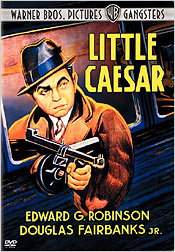 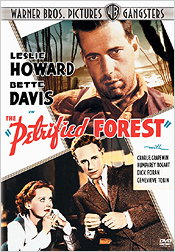 The second Warner Bros. gangster cycle began in 1938. That was the year that James Cagney returned to Warner Bros. after a brief stint at Grand National where he had signed after one of his frequent feuds with Warners. The time was judged right for a return of the gangster film in its full glory and Angels with Dirty Faces kicked the second cycle off in high gear. The glorification of the gangster that had tended to characterize the first cycle was replaced by a more sympathetic approach, but one that ensured full retribution for wrongdoings. In Angels with Dirty Faces, Cagney plays Rocky Sullivan, a New York hoodlum who returns to his childhood neighborhood after his latest stint in jail to seek out his old partner Frasier (Bogart) and return to his involvement in the rackets. There he becomes involved with his childhood friend Jerry (now the local priest - played by Pat O'Brien) and a gang of boys (the Dead End kids) who come to idolize Rocky. This is the quintessential Warner gangster film of the Golden Age - a major production in every sense, including a top-notch cast that also featured Ann Sheridan and George Bancroft, one of the top directors of the era in charge - Michael Curtiz, and a commanding score by Max Steiner. Even with this wealth of talent before and behind the camera, however, it's Cagney that you remember with the shrug of the shoulders and the "whaddya hear, whaddya say" line so indelibly connected with his character. He was rewarded with an Academy Award Best Actor nomination and the New York Film Critics Best Actor Award for his efforts. Equally as good was 1939's The Roaring Twenties, again starring Cagney and featuring Bogart in another sleazy gangster role. The film chronicles the era of the 1920s as experienced by three men who meet in battle during the First World War. The lives of the three of them become intertwined as Prohibition takes root and eventually puts each of them at odds with one another. As Eddie Bartlett - taxi driver turned bootleg liquor kingpin - Cagney delivers another compelling performance of an essentially sympathetic character. In some ways, Eddie's rise and fall reminds one of Rico's in Little Caesar, but the basic characters are markedly different in temperament as are the causes of their downfalls. The film drags one along relentlessly due to its documentary-like style and director Raoul Walsh's deft handling of the action scenes. Its conclusion is one of the most memorable of the era. While The Roaring Twenties was another highlight of the second Warner gangster cycle, later entries such as Each Dawn I Die, Invisible Stripes, and Brother Orchid were also worthy efforts. Bogart had increasingly substantial roles in many of these films and then hit the jackpot in 1941's High Sierra, a film that finally established his star power, but also effectively signaled the end of the second gangster cycle as the studio increasingly turned its attention to the war effort. Cagney departed Warner Bros. soon after to enter independent production with his brother, but many of the resulting films did not live up to expectations and he eventually signed a lucrative new deal with Warners. White Heat in 1949 was the first release under this deal and really kicked the third gangster cycle into high gear. It had first gathered momentum in the late 1940s with the rise of film noir and Key Largo (1948) was Warners' initial key entry with Robinson returning as an old-style gang leader. This final cycle would continue to owe much to the film noir style of the time and would last until the middle of the 1950s.  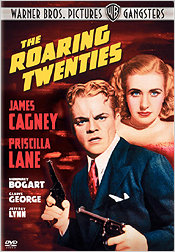 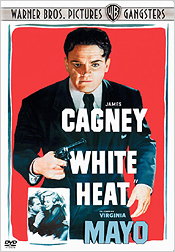 In White Heat, Cagney plays gangster Cody Jarrett. He and his gang carry out a daring train robbery and then try to lay low, but eventually the U.S Treasury Department closes in. To avoid conviction, Cody pleads guilty to a lesser robbery in a different part of the country and is sent to the penitentiary. Unknown to him, however, undercover treasury agent Hank Fallon has been placed in the same cell as Cody, hoping to gather evidence to convict him on the train job, recover the money, and nab the brains behind Cody's heists. Once again, this is a film that is all Cagney. He fashions a compelling portrait of a vicious gangster with a mother fixation who also suffers from increasingly frequent debilitating headaches. The film, with action-expert Raoul Walsh directing, is tough and uncompromising. Killings are carried out as just a standard aspect of doing business, with Cagney coldly pulling the trigger through closed doors or the trunks of cars. As usual, Cagney treats his women cavalierly, although in this case (Virginia Mayo, in a fine performance as two-timing wife Verna) generally deserves it. Great acting support is also provided by Steve Cochran as a double-crossing member of Cody's gang (Big Ed), film noir specialist Edmond O'Brien as Fallon, and Margaret Wycherly as Cody's ma. A commanding score by Max Steiner adds to the film's sense of urgency throughout. The Warner Bros. Pictures Gangsters Collection has been thoughtfully packaged, as we have come to expect from Warners. Each film gets its own disc in the box set with a thorough set of extras. (The individual discs can also be purchased separately, by the way.) The image transfers (all full frame in accord with the original aspect ratios) reflect a substantial restoration effort on Warners' part. None are quite on the same level as the (black and white) standard achieved by Now, Voyager or Mildred Pierce, but White Heat comes very close. It's very sharp with excellent image detail throughout. Black levels are very deep with whites clean and pure. Just slightly behind White Heat in overall quality are Angels with Dirty Faces and The Roaring Twenties. They exhibit some grain and minor speckling, but otherwise offer pleasing film-like transfers. The Petrified Forest, The Public Enemy, and Little Caesar are all a little less stellar that the first three, but still substantial improvements over their previous laserdisc releases. There is more variation in the level of sharpness and more frequent grain in evidence, but shadow detail remains remarkably good. Little Caesar apparently had the most problematic source material, and vertical scratches are very obvious, particularly during the second half of the film. As a package, however, I can't imagine anyone finding fault with what they see here. A remarkable effort from Warners for six very deserving films. The mono sound is completely acceptable for all six films, with the three earliest ones being slightly less robust than the others. Both The Public Enemy and particularly Little Caesar do have some background hiss, but it is not intrusive. White Heat's sound, as with its image transfer, is the richest of the bunch delivering the score with some presence and giving real authority to gunshots. (No one could top Warners for the satisfyingly deep and abrupt cadence of its gunshot sounds.) Each disc includes sub-titles in English, French, and Spanish. Angels with Dirty Faces also includes a French language track. The extras are too extensive to list in detail, but each disc is similarly laid out. There is an audio commentary by a film historian or biographer, a new documentary on the making of the film, and the theatrical trailer. Those providing the commentaries include historians Lincoln Hurst, Richard Jewell, Dana Polan, Robert Sklar, and Drew Casper, and Bogart biographer Eric Lax. All are enthusiastic and knowledgable Warner experts and their thoughts are welcome, informative, and entertaining supplements to the films. These same individuals plus a number of others (such as director Martin Scorcese, film noir expert Alain Silver, film critic Andrew Sarris, and film historian Mark Vieira) provide on-camera comments that, along with film clips, comprise the new making-of documentaries on each disc. Each documentary lasts about 15-20 minutes and gives a good overview of each production, although repetitive of the information conveyed in the audio commentaries. Also included on a couple of the discs are radio adaptations of the films. Not content with this impressive array of extras, Warners also includes a "Warner Night at the Movies" feature on each disc. This provides a range of shorts made in the same year as the film on the disc and replicates the sort of program that a film-goer might see at his or her local theatre at that time. In each case, Leonard Maltin introduces the program which consists of a trailer for another film, a newsreel, a short subject, and a cartoon. The short subjects include the likes of: the musical shorts Rhythmitis, Out Where the Stars Begin, and All Girl Revue; the comedy shorts The Great Library Misery, The Eyes Have It, and So You Think You're Not Guilty, and a Spencer Tracy short The Hard Guy. The cartoons include: Thugs with Dirty Mugs, Smile Darn Ya Smile, Porky and Daffy, Lady Play Your Mandolin, Homeless Hare, and The Coo Coo Nut Grove. With this box set of gangster films, Warner Bros. once again raises the bar on how to present classic films on disc. Of course it helps that they have six films here that are all tremendously entertaining, but the supplementary packaging is thoughtful and truly amazing in quantity and quality. It's only the end of January, but it's clear that this will be easily one of the year's top offerings, classic or otherwise. My highest recommendation! Random Harvest (1942) (released on DVD by Warner Bros. on January 11th, 2005) The novels of James Hilton have fared quite well when adapted for the screen. Somewhat lesser titles such as We Are Not Alone (1939) and Knight without Armour (1937) and the more well-known Goodbye, Mr. Chips (1939) and Lost Horizon (1937) are all good examples. Even 1941's Rage in Heaven is of interest. For my money, though, the filming of Random Harvest was the best outcome of all. There are few films that have a better blend of drama and sentiment, and that can be said to be truly romantic without being cloying, than MGM's 1942 production. |
| Random
Harvest is one of those films about which one can truly
say, "They don't make them like this anymore". Although
the real peak of MGM's glory days was behind it in 1942, the studio
still sported an impressive array of stars and could mount as
opulent a production as any outfit in Hollywood. In this instance,
the reigning queen of the lot Greer Garson was tabbed to appear as
Paula while the understated playing of the handsome and reliable
Ronald Colman was looked to for the role of Smitty/Rainier. The two
make a very attractive couple and generate real chemistry in the
roles, so much so that they make you truly root for their eventual
future together. When the film delivers, you'd want to cheer were
you not so touched by the mood of genuine love and affection that
the principals convey. So sincere is the ending, not to mention the
film throughout, that it will bring a tear to the eye of the most
hardened and no one should feel ashamed to admit to it. The film is
beautifully paced by veteran director Mervyn LeRoy and benefits from
excellent supporting work from Philip Dorn as a doctor at the asylum
and Susan Peters as a young woman enamored of the dashing Rainier.
Lots of Hollywood British regulars like Henry Travers, Reginald
Owen, Alan Napier, Melville Cooper, Una O'Connor, and Rhys Williams
are around to add to the British atmosphere. Are the film's
coincidences a bit excessive? Are the two leading characters almost
impossibly appealing? Does the film lack some message of deeper
meaning? Sure, but who cares? This is entertainment of the highest
order. There are obviously lots of fans of this film out there as it was one of the films selected for release on DVD during Warners' Decision 2004 promotion of last summer. Warner Bros. has done a very nice job with the image transfer (correctly presented full frame). The DVD sports a very film-like look characterized by rich deep blacks, clean whites and a very detailed gray scale. The image is sharp for the most part and has minimal source defects in the form of speckles and scratches. There are no edge effects. Some minor grain is occasionally evident. The mono sound is quite adequate with only a few instances of rather minor hiss. A French mono track and English, French, and Spanish subtitles are also provided. Warner has included a typically fine range of supplements including two enjoyable shorts, both from 1942 and both related to the wartime effort. One is a "Crime Doesn't Pay" entry called Don't Talk while the other is a "Pete Smith Specialty" called Marines in the Making. Also included are the Lux Radio Theater adaptation of the script with Colman and Garson, and trailers for three Greer Garson films (Random Harvest, Mrs. Miniver, and Goodbye, Mr. Chips). Very highly recommended. We Were Strangers (1949) (released on DVD by Columbia on February 22nd, 2005) After a lengthy career at Warner Bros. capped by Key Largo and The Treasure of the Sierra Madre in 1948, director John Huston, as did many of his contemporaries, formed his own independent company, Horizon Pictures. His partner was producer Sam Spiegel, later famous for such films as The Bridge on the River Kwai and Lawrence of Arabia. Horizon's first production was based on "Rough Sketch", a book by Robert Sylvester that concerns a group of Cuban revolutionaries who try to blow up Cuban dictator Gerard Machado in the early 1930s. The film was eventually entitled We Were Strangers. Both John Garfield and Jennifer Jones were agreeable to starring in the film in order to work with Huston, but the script proved to be a problem throughout and with an ending that was rewritten to provide a more upbeat conclusion than originally envisaged, the film failed to reach its potential. It also raised Right Wing hackles as it was seen as Communist propaganda in some quarters, and was one reason for Garfield's eventual summons before HUAC. |
| Despite
the uneven performances, the film's first hour and a half is fairly
compelling as the men struggle to complete the tunnel while China's
movements are closely scrutinized by Ariete. The film's conclusion
is poorly set up in the script, however, and executed so
perfunctorily as to be ridiculous, virtually negating any good will
that the film has generated previously. It almost seems as if Huston
had lost interest by the end of shooting, reportedly perhaps as a
result of personal troubles at the time. Columbia's DVD release does no real favours for the film. The full frame presentation (in accord with the OAR) is acceptable at best. The image is reasonably sharp, but suffers from merely adequate shadow detail. Some night-time scenes are rather murky and are exacerbated by modest grain that is apparent throughout. Speckles and scratches are evident with the latter being more pronounced during the film's second half. The mono sound is unmemorable, but clear enough with little background hiss. Columbia has splurged with subtitles in English, French, Spanish, and Japanese. Supplements consist of the usual three trailers (this time for Castle Keep, Behold a Pale Horse, and Lawrence of Arabia). For John Garfield completists. |
On to Part Two
Barrie Maxwell - Main Page
 |
| Site
designed for 1024 x 768 resolution, using 16M colors and .gif 89a
animation. © 1997-2015 The Digital Bits, Inc., All Rights Reserved. billhunt@thedigitalbits.com |


